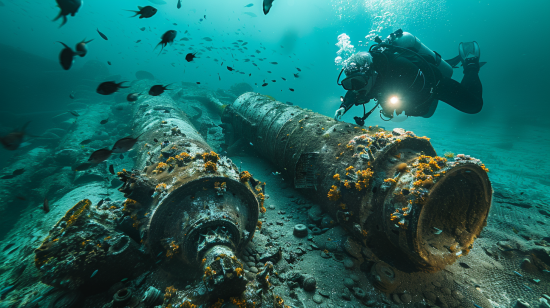Introduction
In the 1980s, a group of divers exploring the depths of Guanabara Bay in Brazil stumbled upon an astonishing discovery: ancient Roman amphorae lying on the ocean floor. These relics, typically associated with the Mediterranean, sparked intense debate and curiosity among historians and archaeologists. How did these Roman artifacts end up in a bay on the other side of the world? The discovery has led to numerous theories, ranging from pre-Columbian trans-oceanic contact to shipwrecks and trade routes. Despite extensive research, the true origin and journey of these Roman relics remain a captivating mystery.
The Discovery
The Initial Find
In 1982, Brazilian underwater archaeologist Robert Marx led an expedition to explore the depths of Guanabara Bay. During the dive, the team discovered several ancient amphorae, the large, two-handled jars commonly used by Romans for transporting goods like wine and olive oil. The amphorae were remarkably well-preserved, lying partially buried in the sediment.
Subsequent Explorations
Following the initial find, several subsequent expeditions were launched to recover more artifacts and gather further evidence. Additional amphorae and fragments were found, all consistent with Roman design and craftsmanship. These discoveries intensified the mystery and prompted more questions about their origin.
Historical Context
Roman Amphorae
Roman amphorae were widely used throughout the Mediterranean from around the 2nd century BCE to the 7th century CE. They were designed for long-distance trade, often carried on ships traversing the Mediterranean and even beyond to parts of Africa, Asia, and Europe. However, finding them in South America was unprecedented.
Guanabara Bay
Guanabara Bay, located in southeastern Brazil, is a natural harbor with a rich history of maritime activity. The bay has been a crucial point of contact for various indigenous cultures, European explorers, and colonial powers. Yet, the presence of Roman relics suggests a connection that predates known history.
Theories and Debates
Pre-Columbian Trans-Oceanic Contact
One of the most intriguing theories suggests that the amphorae are evidence of pre-Columbian trans-oceanic contact. This theory posits that Roman sailors might have reached the Americas long before Columbus. While this idea is controversial and lacks concrete evidence, it has sparked considerable interest and debate.
Shipwreck Hypothesis
Another plausible theory is that a shipwreck carried the amphorae to Guanabara Bay. This could involve a European vessel from the Age of Exploration or a later period, which might have had Roman relics as part of its cargo. The shipwreck hypothesis suggests that these artifacts were brought to the New World by collectors or traders and ended up in the bay through maritime accidents.
Trade Routes and Rediscovery
Some historians propose that the amphorae were brought to Brazil through complex trade networks that spanned continents. These networks could have facilitated the movement of artifacts and goods across vast distances. The amphorae may have been part of an ancient collection or rediscovered during the European colonial period, eventually finding their way to Guanabara Bay.
Scientific Investigations
Carbon Dating and Analysis
To determine the age and authenticity of the amphorae, scientists conducted carbon dating and material analysis. The results confirmed that the artifacts were indeed ancient, dating back to the Roman period. This bolstered the theories of their Roman origin but did not clarify how they arrived in Brazil.
Underwater Archaeology Techniques
Modern underwater archaeology techniques have been employed to explore the site further. These techniques include sonar mapping, sediment analysis, and detailed photographic documentation. Despite these efforts, no definitive evidence has been found to explain the presence of the amphorae in Guanabara Bay.
Cultural and Historical Impact
Local Legends and Myths
The discovery of the Roman relics has inspired local legends and myths in Brazil. Some stories suggest that ancient explorers reached the shores of South America, bringing with them goods and artifacts from distant lands. These legends add a layer of mystique to the already enigmatic discovery.
Influence on Historical Understanding
The Guanabara Bay amphorae have challenged conventional historical narratives about pre-Columbian contact and trade. While mainstream historians remain skeptical of some theories, the discovery has encouraged a reevaluation of long-held beliefs about ancient maritime exploration.
Conclusion
The mystery of the Guanabara Bay Roman relics continues to captivate and intrigue historians, archaeologists, and the public. Despite numerous theories and extensive research, the true story behind these ancient amphorae remains elusive. Whether they represent evidence of pre-Columbian contact, a forgotten shipwreck, or complex trade networks, their presence in Brazil is a testament to the enduring mysteries of our past.
FAQs
1. What are Roman amphorae?
Roman amphorae are large, two-handled jars used in ancient Rome for transporting goods like wine and olive oil. They were commonly used throughout the Mediterranean.
2. Where were the Roman relics found in Brazil?
The Roman relics were discovered in Guanabara Bay, a natural harbor located in southeastern Brazil.
3. What is the leading theory about how the amphorae ended up in Brazil?
There are several theories, including pre-Columbian trans-oceanic contact, a shipwreck carrying Roman relics, and complex trade networks. However, no definitive explanation has been found.
4. How old are the amphorae discovered in Guanabara Bay?
Carbon dating and material analysis have confirmed that the amphorae date back to the Roman period, around the 2nd century BCE to the 7th century CE.
5. What impact has the discovery of the amphorae had on historical understanding?
The discovery has challenged conventional historical narratives about pre-Columbian contact and trade, encouraging a reevaluation of long-held beliefs about ancient maritime exploration.

